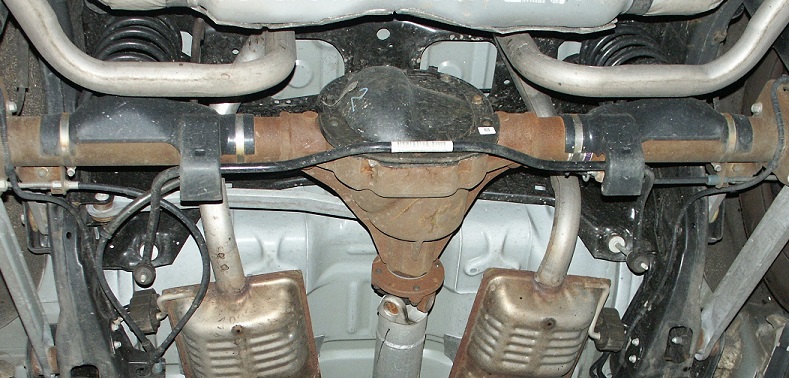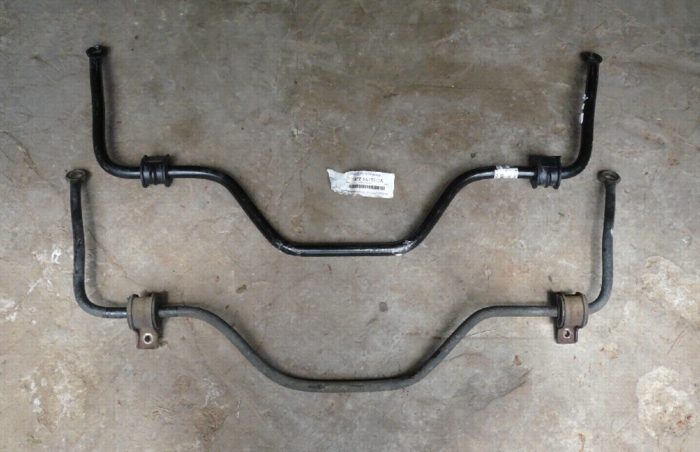  |
 In 1992, Ford began including a rear anti-sway stabilizer bar on the Panther platform. This came stock on all P71 Police Interceptors, Grand Marquis LSE, and Crown Victoria LX-HPP
vehicles. It was also offered as an available option on all other Panther models until the 2003 model year. There were three versions of this anti-sway bar, the 17mm version from 1992-1997, and then the 18mm
version which was the standard for Police, with the 21mm version offered on the LSE and HPP Crown Victorias and also the Marauder. The 21mm (top) and 18mm (bottom) anti-sway bars are shown below:  Adding the rear stabilizer bar to vehicles not currently equipped can greatly enhance the stability and handling of the vehicle while cornering and turning. The rear anti-sway bar tries to keep the car's body flat by moving force from one side of the body to another. This bar helps ensure that traction is improved in the rear suspension by reducing body-roll. In some cases, ride quality can be affected by increased transfer of shock and force to the body on bumpy roads. This is because there is now less isolation between the solid rear axle and the frame of the vehicle. In addition, any shock experienced by one side of the rear suspension will now be partially transferred to the other side of the rear suspension. This decrease in ride quality can be greatly limited by ensuring that rubber end-link and stabilizer bar bushings are used instead of aftermarket polyeurothane. This can also be further improved by limiting the size to a 17mm or 18mm bar. Other changes in handling will be increased over-steer. This is the tendency of the vehicle's rear suspension to want to swing-out under breaking and heavy cornering rather than understeer which is pushing and loss of traction on the front of the vehicle at the cornering limits. Generally, it is recommended to limit the size to a 17mm or 18mm stabilizer bar in the rear unless a larger stabilizer bar has also been used in the front of the vehicle. All Crown Victorias and Grand Marquis come equipped with a front stabilizer bar, but a 21mm rear bar should not be used with the stock front stabilizer bar. The larger 29mm stabilizer bar from the HPP should be used in the front in conjunction with the 21mm in the rear. For the vast majority of drivers, the only noticable difference in handling will be an improved feeling of confidence in the rear suspension. Adding the rear anti-sway stabilizer bar is fairly straight-forward. The bar is primarily attached at its main anchoring points at the bottom of the solid rear axle. The bar is held in place using two thick rubber bushings that are clamped by two large brackets. The slots for the brackets already exist on all Crown Victorias. From this point, the anti-sway bar is then fixed to the upper frame support using end-link components. The image below shows all of the components that will need to be scavenged from the donor vehicle. (click here for a close-up of the hardware) The hardware includes the following items: • End-Link Bushing Set (4 per side, 8 total) (LH/RH) • Sway-Bar Bushing Set (1 per side, 2 total) (LH/RH) • End-Link Washers (4 total) • End-Link Bushing Caps (4 total) • End-Link Rods (1 per side, 2 total) • Frame to Stabilizer Bracket (1 per side, 2 total) • Frame to Stabilizer Bracket Retaining Nut (1 per side, 2 total) • Frame to Stabilizer Bracket Retaining Bolt (1 per side, 2 total) Installation is as simple as reversing the removal process. It is generally easier to hand-tighten the upper portions of the end-links to the frame so that they hang down, ready to accept the stabilizer bar, then mount the stabilizer bar on the live axle, and then attach the lower portion of the end-links to the sway bar. Note: you may need to lower the vehicle somewhat to gain enough clearance on the end-links. When everything is assembled, finish the installation by tightening all bolts and ensuring they are snug.
|